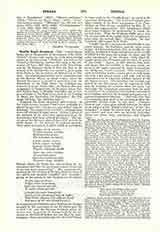

Vezina Regis Prodeunt. —This “world-famous hymn, one of the grandest in the treasury of the Latin Church” (Neale), and “surely one of the most stirring strains in our hymnology” (Duffield), was written by Venantius Fortunatus, and was first sung in the procession (November 19, 569) when a relic of the True Cross, sent by the Emperor Justin II from the East at the request of St. Radegunda, was carried in great pomp from Tours to her monastery of Saint-Croix at Poi-tiers. Its original processional use is commemorated in the Roman Missal on Good Friday, when the Blessed Sacrament is carried in procession from the Repository to the High Altar. Its principal use, however, is in the Divine Office, the Roman Breviary assigning it to Vespers from the Saturday before Passion Sunday daily to Maundy Thursday, and to Vespers of feasts of the Holy Cross, such as the Finding (May 3), the Exaltation (September 14), the Triumph (July 16, “pro aliquibus locis”).
Originally the hymn comprised eight stanzas. In the tenth century, stanzas 7 and 8 were gradually replaced by new ones (“O crux ave, spes unica”, and the doxology, “Te summa Deus trinitas”), although they were still retained in some places. Stanza 2 survived the omission of the other two, and passed from the manuscripts into many printed breviaries. The correctors of the Breviary under Urban VIII revised the whole hymn in the interest of classical prosody. They omitted stanzas 2, 7, and 8, which are as follows:
Confixa clavis viscera Tendens manus, vestigial Redemptionis gratia Hic immolata est hostia.
Fundis aroma cortice, Vincis sapore nectare, Iucunda fructu fertili Plaudis triumpho nobili.
Salve ara, salve victima De passionis Gloria Qua vita mortem pertulit Et morte vitam reddidit.
Pimont thinks the hymn has lost nothing by the omissions, and that “its movement is more active and its unction more penetrating”. The correctors also replaced the last two lines of the first stanza by those of the eighth, and changed “reddidit” into “protulit”, giving us the stanza as now found in our breviaries:
Vexilla regis prodeunt,
Fulget crucis mysterium,
Qua vita mortem pertulit Et morte vitam protulit.
[Abroad the royal banners fly And bear the gleaming Cross on high—That Cross whereon Life suffered death And gave us life with dying breath.]
It is unnecessary to indicate more in detail the changes wrought by the correctors, as our Breviaries give the revised text, and the Vatican Graduale gives the ancient text. In general, the changes made by the correctors in the Church hymns are not liked by hymnologists. Some exceptions taken by the Abbe Pimont to those made in the “Vexilla Regis” are noted in the appended bibliography. The Vatican Graduale gives plain evidence of the desire and purpose of the Commission on Plain Chant, established by Pius X, to restore the original texts. The Antiphonary (1912) gives equal evidence of an intention to retain the revised texts. Thus the Graduale (1908) gives only the ancient form of the hymn, while the Antiphonary gives only the revised form. Curiously, the Processionale (1911) gives both forms.
” Vexilla” has been interpreted symbolically to represent baptism, the Eucharist, and the other sacraments. Clichtoveus explains that as vexilla are the military standards of kings and princes, so the vexilla of Christ are the cross, the scourge, the lance, and the other instruments of the Passion “with which He fought against the old enemy and cast forth the prince of this world”. Kayser (p. 397) dissents from both, and shows that the vexillum is the cross which (instead of the eagle) surmounted, under Constantine, the old Roman cavalry standard. This standard became in Christian hands a square piece of cloth hanging from a bar placed across a gilt pole, and having embroidered on it Christian symbols instead of the old Roman devices. The splendor and triumph suggested by the first stanza can be appreciated fully only by recalling the occasion when the hymn was first sung—the triumphant procession from the walls of Poitiers to the monastery, with bishops and princes in attendance and with all the pomp and pageantry of a great ecclesiastical function. “And still, after thirteen centuries, how great is our emotion as these imperishable accents come to our ears!” (Pimont). Gounod took a very plain melody based on the chant as the subject of his “March to Calvary” in the “Redemption“, in which the chorus sings the text at first very slowly and then, after an interval, fortissimo. There are about forty translations into English verse.
H. T. HENRY

